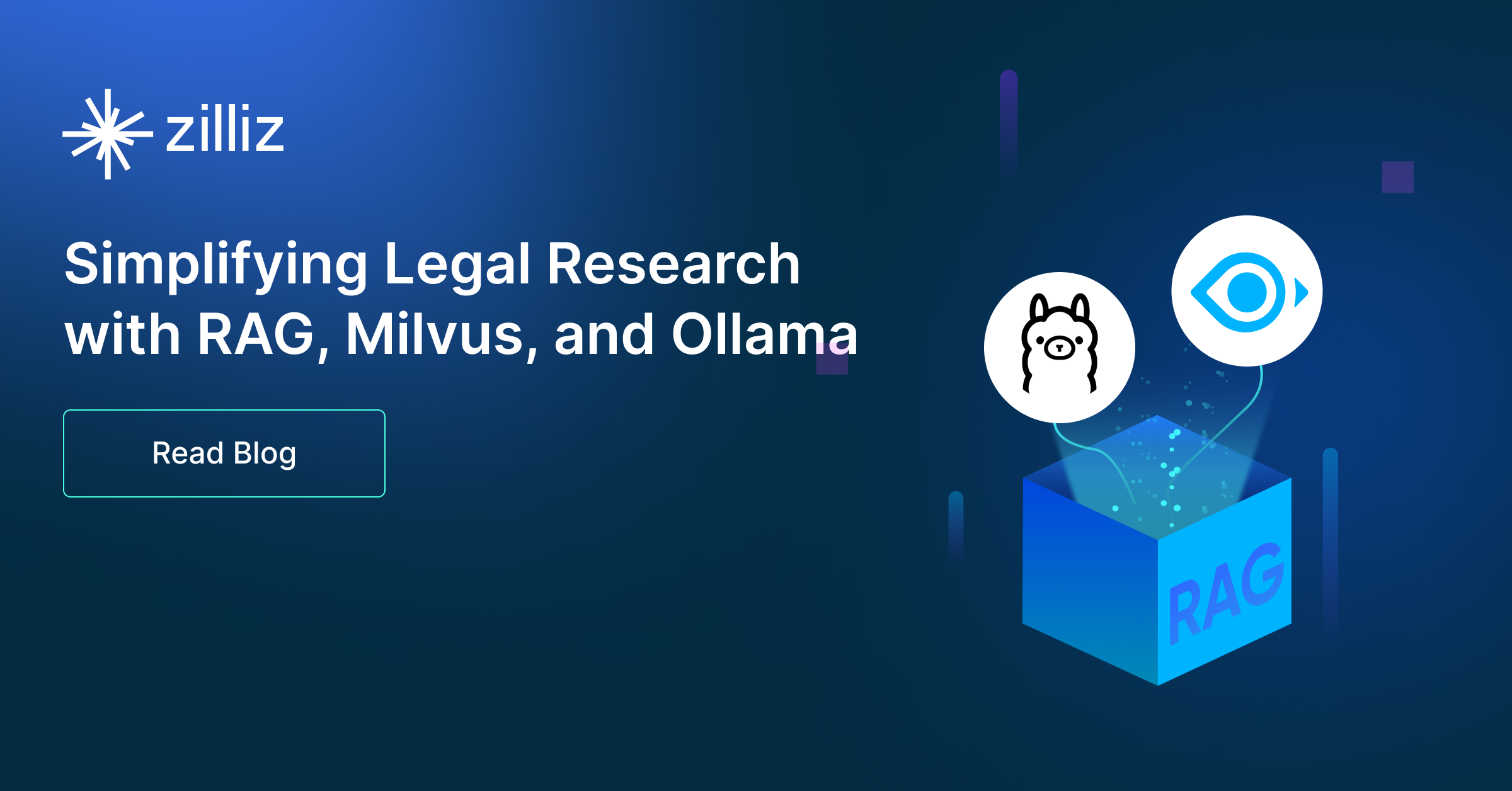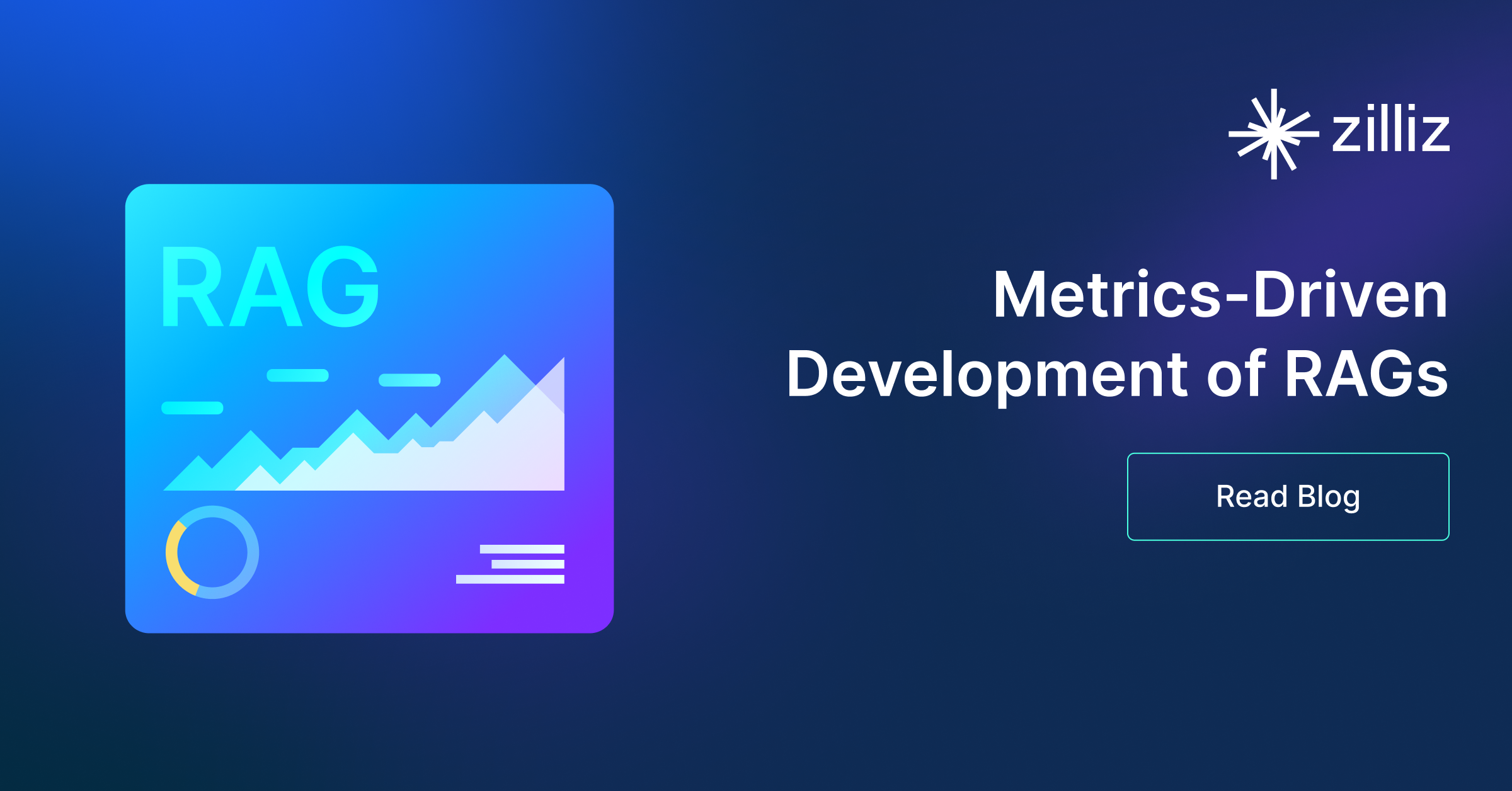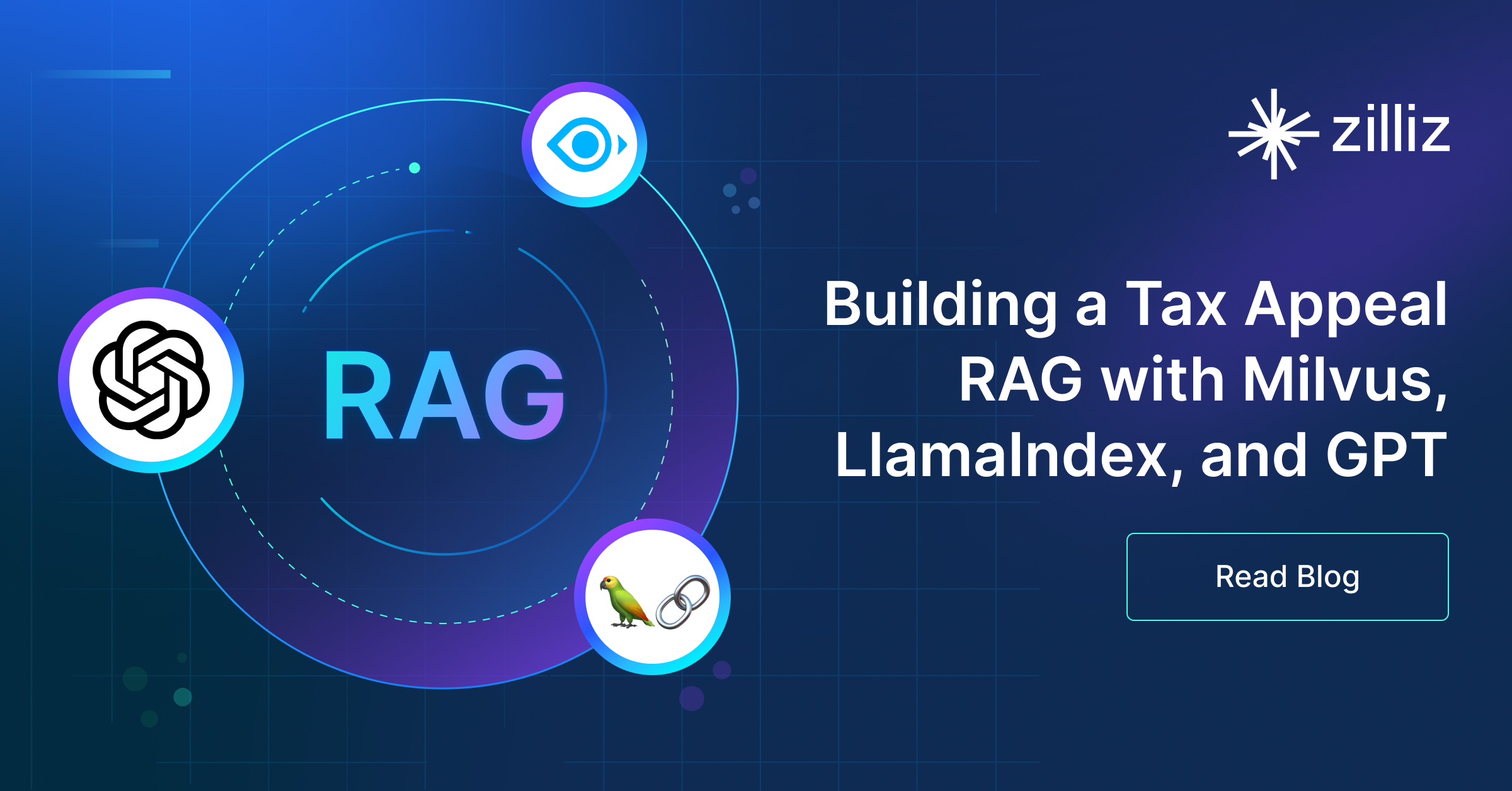Build RAG Chatbot with Llamaindex, Zilliz Cloud, OpenAI GPT-o1, and Ollama granite-embedding
Introduction to RAG
Retrieval-Augmented Generation (RAG) is a game-changer for GenAI applications, especially in conversational AI. It combines the power of pre-trained large language models (LLMs) like OpenAI’s GPT with external knowledge sources stored in vector databases such as Milvus and Zilliz Cloud, allowing for more accurate, contextually relevant, and up-to-date response generation. A RAG pipeline usually consists of four basic components: a vector database, an embedding model, an LLM, and a framework.
Key Components We'll Use for This RAG Chatbot
This tutorial shows you how to build a simple RAG chatbot in Python using the following components:
- Llamaindex: a data framework that connects large language models (LLMs) with various data sources, enabling efficient retrieval-augmented generation (RAG). It helps structure, index, and query private or external data, optimizing LLM applications for search, chatbots, and analytics.
- Zilliz Cloud: a fully managed vector database-as-a-service platform built on top of the open-source Milvus, designed to handle high-performance vector data processing at scale. It enables organizations to efficiently store, search, and analyze large volumes of unstructured data, such as text, images, or audio, by leveraging advanced vector search technology. It offers a free tier supporting up to 1 million vectors.
- OpenAI GPT-1: A foundational transformer-based language model designed for natural language understanding and generation. Strengths include coherent text generation, contextual comprehension, and adaptability to diverse NLP tasks. Ideal for text completion, basic conversational agents, and early-stage language research, serving as a precursor to more advanced models like GPT-3 and GPT-4.
- Ollama Granite-Embedding: A high-performance embedding model designed for semantic understanding and retrieval tasks. It excels at generating dense vector representations for text, enabling robust similarity search, clustering, and retrieval-augmented generation (RAG). Ideal for enterprise applications requiring scalable, privacy-preserving semantic analysis in on-premises or edge environments.
By the end of this tutorial, you’ll have a functional chatbot capable of answering questions based on a custom knowledge base.
Note: Since we may use proprietary models in our tutorials, make sure you have the required API key beforehand.
Step 1: Install and Set Up Llamaindex
pip install llama-index
Step 2: Install and Set Up OpenAI GPT-o1
%pip install llama-index llama-index-llms-openai
from llama_index.llms.openai import OpenAI
llm = OpenAI(
model="o1",
# api_key="some key", # uses OPENAI_API_KEY env var by default
)
Step 3: Install and Set Up Ollama granite-embedding
%pip install llama-index-embeddings-ollama
from llama_index.embeddings.ollama import OllamaEmbedding
embed_model = OllamaEmbedding(
model_name="granite-embedding",
)
Step 4: Install and Set Up Zilliz Cloud
pip install llama-index-vector-stores-milvus
from llama_index.core import VectorStoreIndex, StorageContext
from llama_index.vector_stores.milvus import MilvusVectorStore
vector_store = MilvusVectorStore(
uri=ZILLIZ_CLOUD_URI,
token=ZILLIZ_CLOUD_TOKEN,
dim=1536, # You can replace it with your embedding model's dimension.
overwrite=True,
)
Step 5: Build a RAG Chatbot
Now that you’ve set up all components, let’s start to build a simple chatbot. We’ll use the Milvus introduction doc as a private knowledge base. You can replace it with your own dataset to customize your RAG chatbot.
import requests
from llama_index.core import SimpleDirectoryReader
# load documents
url = 'https://raw.githubusercontent.com/milvus-io/milvus-docs/refs/heads/v2.5.x/site/en/about/overview.md'
example_file = 'example_file.md' # You can replace it with your own file paths.
response = requests.get(url)
with open(example_file, 'wb') as f:
f.write(response.content)
documents = SimpleDirectoryReader(
input_files=[example_file]
).load_data()
print("Document ID:", documents[0].doc_id)
storage_context = StorageContext.from_defaults(vector_store=vector_store)
index = VectorStoreIndex.from_documents(
documents, storage_context=storage_context, embed_model=embed_model
)
query_engine = index.as_query_engine(llm=llm)
res = query_engine.query("What is Milvus?") # You can replace it with your own question.
print(res)
Example output
Milvus is a high-performance, highly scalable vector database designed to operate efficiently across various environments, from personal laptops to large-scale distributed systems. It is available as both open-source software and a cloud service. Milvus excels in managing unstructured data by converting it into numerical vectors through embeddings, which facilitates fast and scalable searches and analytics. The database supports a wide range of data types and offers robust data modeling capabilities, allowing users to organize their data effectively. Additionally, Milvus provides multiple deployment options, including a lightweight version for quick prototyping and a distributed version for handling massive data scales.
Optimization Tips
As you build your RAG system, optimization is key to ensuring peak performance and efficiency. While setting up the components is an essential first step, fine-tuning each one will help you create a solution that works even better and scales seamlessly. In this section, we’ll share some practical tips for optimizing all these components, giving you the edge to build smarter, faster, and more responsive RAG applications.
LlamaIndex optimization tips
To optimize LlamaIndex for a Retrieval-Augmented Generation (RAG) setup, structure your data efficiently using hierarchical indices like tree-based or keyword-table indices for faster retrieval. Use embeddings that align with your use case to improve search relevance. Fine-tune chunk sizes to balance context length and retrieval precision. Enable caching for frequently accessed queries to enhance performance. Optimize metadata filtering to reduce unnecessary search space and improve speed. If using vector databases, ensure indexing strategies align with your query patterns. Implement async processing to handle large-scale document ingestion efficiently. Regularly monitor query performance and adjust indexing parameters as needed for optimal results.
Zilliz Cloud optimization tips
Optimizing Zilliz Cloud for a RAG system involves efficient index selection, query tuning, and resource management. Use Hierarchical Navigable Small World (HNSW) indexing for high-speed, approximate nearest neighbor search while balancing recall and efficiency. Fine-tune ef_construction and M parameters based on your dataset size and query workload to optimize search accuracy and latency. Enable dynamic scaling to handle fluctuating workloads efficiently, ensuring smooth performance under varying query loads. Implement data partitioning to improve retrieval speed by grouping related data, reducing unnecessary comparisons. Regularly update and optimize embeddings to keep results relevant, particularly when dealing with evolving datasets. Use hybrid search techniques, such as combining vector and keyword search, to improve response quality. Monitor system metrics in Zilliz Cloud’s dashboard and adjust configurations accordingly to maintain low-latency, high-throughput performance.
OpenAI GPT-01 optimization tips
To optimize OpenAI GPT-01 in a RAG setup, fine-tune prompts to include explicit instructions and structured context (e.g., “Answer using: [retrieved text]”). Limit response length with max_tokens to reduce verbosity and cost. Use a lower temperature (0.2–0.5) for factual accuracy. Preprocess retrieved documents to remove irrelevant content, ensuring inputs fit token limits. Cache frequent queries to minimize API calls. Experiment with chunking strategies for context injection and prioritize critical information at the prompt’s start or end. Monitor latency and adjust batch sizes for throughput efficiency.
Ollama Granite-Embedding optimization tips
To optimize Ollama Granite-Embedding in RAG, ensure input text is cleanly chunked (avoid truncation by splitting documents into 512-token segments). Fine-tune embedding parameters like temperature and batch size for speed-quality balance. Use hardware acceleration (e.g., CUDA) and quantize the model for faster inference. Normalize embeddings to improve similarity calculations. Regularly evaluate retrieval accuracy with benchmarks like NDCG or recall@k. Cache frequent queries to reduce redundant computations, and pre-filter low-relevance documents using metadata to lighten embedding workloads.
By implementing these tips across your components, you'll be able to enhance the performance and functionality of your RAG system, ensuring it’s optimized for both speed and accuracy. Keep testing, iterating, and refining your setup to stay ahead in the ever-evolving world of AI development.
RAG Cost Calculator: A Free Tool to Calculate Your Cost in Seconds
Estimating the cost of a Retrieval-Augmented Generation (RAG) pipeline involves analyzing expenses across vector storage, compute resources, and API usage. Key cost drivers include vector database queries, embedding generation, and LLM inference.
RAG Cost Calculator is a free tool that quickly estimates the cost of building a RAG pipeline, including chunking, embedding, vector storage/search, and LLM generation. It also helps you identify cost-saving opportunities and achieve up to 10x cost reduction on vector databases with the serverless option.
 Calculate your RAG cost
Calculate your RAG cost
What Have You Learned?
Congratulations on making it through this exciting tutorial! You've dived into the fascinating world of Retrieval-Augmented Generation (RAG) systems and learned how to seamlessly integrate a powerful framework like LlamaIndex with a next-gen vector database like Zilliz Cloud, the incredible OpenAI GPT-o1 language model, and the Ollama granite-embedding model. By understanding how these components interact, you now have the tools to build a robust RAG pipeline that enhances your applications with rich and pertinent information retrieval alongside advanced text generation. Each piece of technology plays a vital role; from LlamaIndex’s efficient data handling to Zilliz's lightning-fast retrieval capabilities, topped off with the AI-driven text generation of OpenAI's GPT-o1 and the insightful embeddings of Ollama. You’ve unlocked a myriad of possibilities for creating responsive and intelligent applications!
Additionally, let’s not forget the handy optimization tips and the awesome free RAG cost calculator we introduced! These tools will empower you to fine-tune your system, ensuring you get the most out of your setup while keeping costs manageable. Now that you’re equipped with this knowledge, it’s time for you to roll up your sleeves and start building your own RAG applications. Whether you aim to innovate in customer service or enhance creative writing, the sky’s the limit! Embrace the journey ahead, and don’t hesitate to experiment, optimize, and make this technology your own. Happy building!
Further Resources
🌟 In addition to this RAG tutorial, unleash your full potential with these incredible resources to level up your RAG skills.
- How to Build a Multimodal RAG | Documentation
- How to Enhance the Performance of Your RAG Pipeline
- Graph RAG with Milvus | Documentation
- How to Evaluate RAG Applications - Zilliz Learn
- Generative AI Resource Hub | Zilliz
We'd Love to Hear What You Think!
We’d love to hear your thoughts! 🌟 Leave your questions or comments below or join our vibrant Milvus Discord community to share your experiences, ask questions, or connect with thousands of AI enthusiasts. Your journey matters to us!
If you like this tutorial, show your support by giving our Milvus GitHub repo a star ⭐—it means the world to us and inspires us to keep creating! 💖
- Introduction to RAG
- Key Components We'll Use for This RAG Chatbot
- Step 1: Install and Set Up Llamaindex
- Step 2: Install and Set Up OpenAI GPT-o1
- Step 3: Install and Set Up Ollama granite-embedding
- Step 4: Install and Set Up Zilliz Cloud
- Step 5: Build a RAG Chatbot
- Optimization Tips
- RAG Cost Calculator: A Free Tool to Calculate Your Cost in Seconds
- What Have You Learned?
- Further Resources
- We'd Love to Hear What You Think!
Content
Vector Database at Scale
Zilliz Cloud is a fully-managed vector database built for scale, perfect for your RAG apps.
Try Zilliz Cloud for Free


